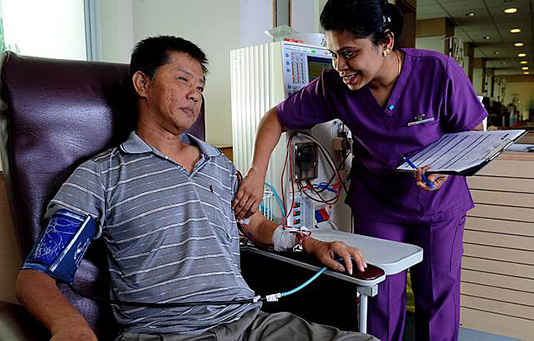Chronic kidney disease (CKD), also known as chronic kidney failure, affects over 10% of the global population, impacting more than 800 million individuals worldwide (Jager et al., 2019).
Currently, the Philippines is experiencing a sudden rise in chronic kidney disease cases. With approximately one Filipino developing kidney failure every hour, this translates to about 120 cases per million people annually (PSN, 2024). This trend signifies an increasing demand for dialysis services, as millions of Filipinos are affected by CKD. The prevalence of CKD in the Philippines is notably higher than the global average, with estimates suggesting that about 35.94% of the population is affected (Pajimna et al., 2023). As the number of individuals requiring dialysis continues to grow, so does the need for specialized healthcare professionals, particularly dialysis nurses.

Dialysis nurses play an important role in managing the care of patients undergoing dialysis, ensuring that these life-saving treatments are administered effectively and safely. Their responsibilities encompass not only the technical aspects of dialysis but also providing emotional support and health education to patients and their families. As the healthcare sector continues to evolve, the demand for skilled dialysis nurses is becoming increasingly important to meet the growing needs of patients with kidney disease.
In this context, understanding the roles and responsibilities of a dialysis nurse is essential for addressing the challenges posed by the rising incidence of kidney disease and ensuring that patients receive the best possible care.
The Kidneys
The kidney is considered one of the vital organs of our body. Its job is to filter toxins and waste materials from our blood. These wastes and toxins come from the medications we are taking, food, and other vital processes of the body. When the kidneys are damaged, these waste materials stay inside the body and result in various health diseases and multi-organ failure.
Two Types of Dialysis and How They Work
When kidneys fail, dialysis serves as an aid to help filter blood, removing waste and excess fluids. There are two main types of dialysis: hemodialysis and peritoneal dialysis. Hemodialysis involves using an external machine to filter the blood outside of the body, while peritoneal dialysis uses the lining of your abdomen as a natural filter inside your body.
In hemodialysis, blood is pumped out of your body and into a dialysis machine, also called a dialyzer, which filters out waste and extra fluid. The cleaned blood is then returned to your body through tubes connected to the machine. This process usually requires minor surgery to create an access point (either fistula or graft), typically in your arm, to easily draw blood and return it after filtration. Hemodialysis is commonly done at a dialysis center three times a week, with each session lasting about four hours, but it can also be performed at home with a slightly different schedule.
Peritoneal dialysis, on the other hand, filters blood inside your body. A catheter, or soft tube, known as a peritoneal catheter, is surgically placed in your abdomen. A cleansing fluid called dialysate is introduced into your belly through the catheter, drawing out extra fluid and waste products from your blood as it flows through the area. After a few hours, the fluid is drained from your belly using the same catheter. Peritoneal dialysis can be done almost anywhere, offering more flexibility and convenience compared to hemodialysis. There are different types of peritoneal dialysis, including Continuous Ambulatory Peritoneal Dialysis (CAPD) and Automated Peritoneal Dialysis (APD), each with varying schedules and equipment needs.
Requirements to be a Dialysis Nurse
In the Philippines, based on Department of Health Administrative Order No. 163, s. 2004: Rules and Regulations Governing the Registration, Licensure, and Operation of Dialysis Clinics in the Philippines, the following are the requirements to be a dialysis nurse in the Philippines:
• Must be duly licensed.
• Must be a current member of the Renal Nursing Association of the Philippines (ReNAP) or its equivalent.
• Must be a certified IV therapy nurse.
• Must have at least six (6) months of hospital or clinical work experience.
• Must possess certificates of special training on dialysis for no less than thirty (30) days and on Basic Life Support.
• At least one nurse per shift must have Advanced Life Support training.
In the US, you’ll also need to follow a series of steps involving education, licensure, and gaining specific experience in nephrology. The first step is to obtain a nursing degree from an accredited program. You can choose to pursue a Licensed Practical Nurse (LPN) diploma, an Associate Degree in Nursing (ADN), or a Bachelor of Science in Nursing (BSN). While an LPN/LVN program is a quicker route, many facilities prefer or require an RN license, making an ADN or BSN more advantageous. ADN programs usually take two years, while BSN programs typically take four.
After completing your nursing program, you must pass the National Council Licensure Examination (NCLEX) to become a licensed practical or registered nurse. The NCLEX-PN is for LPNs, and the NCLEX-RN is for RNs. To qualify for the exam, you need to apply and register in your state, pay the required fee, study for the test using available resources, and take the exam at an official testing center. Upon passing the NCLEX, you can apply for licensure in your state and begin practicing as a nurse.
To specialize in dialysis, gaining experience in nephrology nursing is essential. While not always required, becoming a Certified Dialysis Nurse (CDN) can boost your job prospects. To be eligible for the CDN exam, you generally need a current, unrestricted RN license in the U.S., a minimum of 2,000-3,000 hours of experience in nephrology nursing within the past two years, and completion of 20 or more continuing education hours in nephrology nursing. The Nephrology Nursing Certification Commission (NNCC) offers the CDN examination online.
Roles and Responsibilities of a Dialysis Nurse
A dialysis nurse plays an important role in the lives of patients with kidney failure. They administer dialysis, carefully manage medications, and meticulously track patients’ progress and medical history. Dialysis nurses prioritize patients’ well-being, delivering quality care with excellent communication and the ability to thrive in a fast-paced environment. Their expertise makes them a vital component of the healthcare team, and the role offers a fulfilling career path for individuals dedicated to patient care.
The following are the responsibilities of a dialysis nurse based on DOH guidelines:
- Provides direct care to patients undergoing HD based on the rules and regulations established by DOH and approved company policies and procedures;
- Checks and prepares all materials needed and ensures they are available before the start of dialysis;
- Reads and carries out doctors’ orders and ensures that dialysis is performed accordingly;
- Assesses patient using the nursing process before, during, and after dialysis;
- Assesses, inspects, regulates, and monitors all machine settings and parameters;
- Prepares patients’ access using the required standards for arteriovenous fistula and external access preparation;
- Communicates with the doctor regarding identified patient-related problems and initiate interventions for the same;
- Administers medications as ordered and properly documents them;
- Performs, monitors, and records pre-, intra-, and post-dialysis treatment vital signs;
- Initiates/performs Cardio-Pulmonary Resuscitation (CPR) in the event of cardiac and/or pulmonary arrest and sees to it that all activities are supervised, organized, and documented;
- Updates patients’ records during and after every dialysis session;
- Inventories e-cart medicines and ward stocks at the end of every shift;
- Protects patients from accidents, hazards, and potential infections;
- Observes the line of communication and applies appropriate communication techniques in reporting, recording, and relaying information or data;
- Provides information and health education to patients and significant others regarding the plan of care.
In the US, the following are the responsibilities of a dialysis nurse according to the American Association of Managed Care Nurses:
- Administer dialysis treatments as prescribed by a physician.
- Monitor patients’ vital signs before, during, and after the procedure.
- Provide health education to patients and their families about kidney disease, dialysis processes, and home care options.
- Prepare and maintain dialysis machines and ensure their proper functioning.
- Maintain a safe, sterile environment to minimize infection risks.
- Assess patients’ responses to treatment and adjust care plans as needed.
- Document and report any changes in the patient’s conditions to the healthcare team.
- Collaborate with dietitians, social workers, and other professionals to provide holistic patient care.
- Offer emotional support to patients and their families during treatment.
- Participate in professional development and stay updated on best practices in nephrology nursing.
- Follow safety protocols and healthcare standards.
Salary and Career Outlook: Dialysis Jobs in the US & Philippines
Dialysis nurses in the U.S. earn an average salary of around $90,167 per year or $43.35 per hour. However, reported averages can vary from $86,452 to $104,618 per year. Experience affects pay, with entry-level RNs earning around $32.74 per hour. Higher education, such as a Bachelor of Science in Nursing (BSN), and certifications like Certified Hemodialysis Nurse (CHN), can increase earning potential. Location also plays a significant role; for example, the highest-paying state for dialysis nurses is California, with an average yearly salary of $129,618.
In the Philippines, dialysis nurses earn a salary range between Php 24,000 – Php 35,000 pesos. However, those with more experience and certifications have the potential to earn more than this range. Other factors that can affect their salary include education and location. Job demand for dialysis nurses is projected to grow, driven by the increasing prevalence of end-stage renal disease.
The work settings are diverse, ranging from hospitals and dialysis clinics to patients’ homes. They also have flexible work schedules, such as longer shifts with more days off, promoting a better work-life balance than bedside nursing. To advance as a nephrology nurse, gaining experience as an RN or LPN is essential, with the Nephrology Nursing Certification Commission (NNCC) requiring at least 3,000 hours of clinical nephrology work. Certification options include Certified Dialysis Nurse (CDN) and Certified Nephrology Nurse (CNN), enhancing expertise and career prospects. Continuous learning through workshops and conferences is also important in this constantly evolving field. This role will build strong, lasting relationships with patients and their families, making a significant positive impact on their lives through compassionate care and essential treatment.
Future Trends in Dialysis Care
Here are some future trends in dialysis care:
Personalized and Convenient Dialysis
One major trend is making dialysis more personalized and convenient for patients. Instead of a one-size-fits-all approach, new technologies use artificial intelligence and machine learning to tailor treatments to each patient’s specific needs. This includes optimizing dialysis prescriptions based on real-time data and predicting potential complications before they become severe. Wearable and portable dialysis devices, resembling small backpacks, are also being developed to allow patients to receive treatment while going about their daily lives, offering greater mobility and flexibility. Home hemodialysis machines with user-friendly interfaces and remote monitoring capabilities are also making it easier for patients to dialyze in the comfort of their own homes.
Digital Health and Telemedicine
Digital health technologies and telemedicine are playing an increasingly important role in dialysis care. Remote monitoring and consultations allow healthcare providers to closely track patients’ progress and adjust treatment plans as needed. Telemedicine helps provide healthcare services and support to individuals undergoing dialysis treatment, which is especially valuable for those in remote areas or with limited mobility. Digital tools also facilitate self-care and remote care support for hemodialysis patients.
Innovations and Long-Term Goals
Looking further into the future, researchers are working on developing artificial kidneys that can replicate the functions of natural kidneys more effectively, reducing the reliance on traditional dialysis treatments. There’s also a focus on improving the availability of kidney transplants, as transplantation is still considered the best treatment for kidney failure. Other areas of interest include bioengineered devices and using animals to grow organs suitable for transplantation. Ultimately, the goal is to create dialysis therapies that not only improve survival rates but also enhance patients’ quality of life by reducing symptom burden and enabling them to live more fulfilling lives.
Conclusion
Considering the growing number of individuals affected by kidney disease, it’s clear that dialysis nurses are more vital than ever. They’re not just technicians operating machines; they are lifelines for their patients, offering a unique blend of medical expertise, emotional support, and genuine compassion during a difficult time. As we look to the future, it’s important to remember that investing in these dedicated professionals – through better training, resources, and recognition – is an investment in the well-being of our communities. Let’s encourage aspiring nurses to consider this rewarding path and ensure that those already serving have what they need to provide the best possible care, making a real difference in the lives of those battling kidney disease.
References
- Jager K.J., Kovesdy C., Langham R., et al.(2019). A single number for advocacy and communication-worldwide more than 850 million individuals have kidney diseases. Kidney Int. doi: 10.1016/j.kint.2019.07.012.
- Support, P. W. (2024, March 1). Rising incidence of chronic kidney disease in the Philippines sparks call for kidney health awareness subtitle: The Philippine Society of Nephrology urges Filipinos to take proactive measures. Philippine Society of Nephrology. https://psn.org.ph/2024/03/01/rising-incidence-of-chronic-kidney-disease-in-the-philippines-sparks-call-for-kidney-health-awareness-subtitle-the-philippine-society-of-nephrology-urges-filipinos-to-take-proactive-measures/
- DOH ADMINISTRATIVE ORDER NO. 2012 – 0001 – NEW RULES AND REGULATIONS GOVERNING THE LICENSURE AND REGULATION OF DIALYSIS FACILITIES IN THE PHILIPPINES – supreme court E-library. (n.d.). Gov.Ph. Retrieved March 8, 2025, from https://elibrary.judiciary.gov.ph/thebookshelf/showdocs/10/50687
- Pajimna, Janine Audrei T. et al. (2023). Gaps and challenges in the provision of treatment for patients with end-stage renal disease: perspectives from the Philippines. The Lancet Regional Health – Western Pacific, Volume 38, 100889. Retrieved from https://www.thelancet.com/journals/lanwpc/article/PIIS2666-6065(23)00207-9/fulltext
- Registered Nurse- Dialysis nurse salary in the Philippines. Retrieved March 9, 2025, from https://ph.indeed.com/career/registered-nurse-%20-dialysis/salaries
- Dialysis Nurse. (n.d.). Sigma Nursing. Retrieved March 9, 2025, from https://jobs.sigmanursing.org/salary/dialysis-nurse
- The future of kidney dialysis. (2025a, January 17). Stanford University School of Engineering. https://engineering.stanford.edu/news/future-kidney-dialysis
- Chakraborty, S. (2023, October 10). Transforming kidney health: Innovations and trends in dialysis care. Linkedin.com. https://www.linkedin.com/pulse/transforming-kidney-health-innovations-trends-care-sneha-chakraborty/
- New era in kidney care is on the horizon. (n.d.). Fresenius Medical Care. Retrieved March 9, 2025, from https://freseniusmedicalcare.com/en/media/insights/company-features/new-era-in-kidney-care-is-on-the-horizon/
- Himmelfarb, J., Vanholder, R., Mehrotra, R., & Tonelli, M. (2020). The current and future landscape of dialysis. Nature reviews. Nephrology, 16(10), 573–585. https://doi.org/10.1038/s41581-020-0315-4
- Dialysis Nurse job description. (n.d.). American Association of Managed Care Nurses (AAMCN). Retrieved March 8, 2025, from https://careers.aamcn.org/career/dialysis-nurse/job-descriptions



![Roles and Functions of a Nurse: Salary and Career Outlook [Updates 2025] Smiling Asian female nurse with arms crossed](https://rnspeak.com/wp-content/uploads/2017/10/smiling-asian-female-healthcare-worker-with-arms-238x178.jpg)




